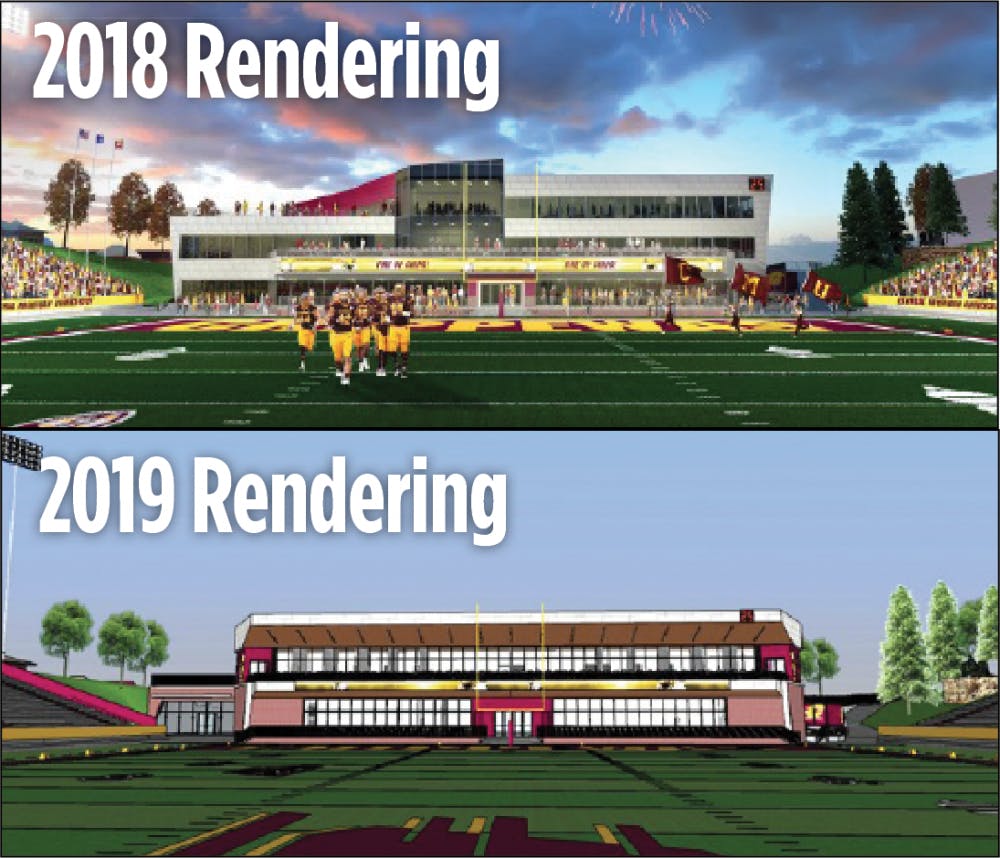EDITORIAL: No more operating under a different set of rules, athletics

Last week we published a story about how the plan for the $32.5 million-dollar addition to Kelly/Shorts Stadium – the Chippewa Champions Alumni Center – was significantly scaled back after it was approved by the board of trustees in 2018.
That story may have been the first time you read about the changes to this high-profile, expensive athletics project. Odd, right? We thought the same thing.
In an Aug. 12 press release that touted “exciting changes” coming to the game day experience one redesigned rendering of the building was featured. The center looked significantly different, and smaller, than what we were told to expect in Fall 2020. Amazingly, there was no explanation whatsoever about why the new image – of the Chippewa Champions Center (notice the word Alumni was removed from the name of the center) – is missing its third floor.
Let’s compare the announcement of two recent high-profile academic building projects and the roll-out of the Chippewa Champions Center.
The Center for Integrated Health Studies was announced in 2014. At the earliest stage of planning, we knew the project would cost $26 million, with $6.5 million coming from the university. The building served a specific, stated purpose, too. It included classrooms, a 150-seat auditorium, laboratories dedicated to programs like the physician assistant program and the physical therapy program.
When the Biosciences Building was announced in 2013 we were told it would cost $95 million dollars, including a $30 million allocation from the state. That meant the rest was coming from the university. It opened, under budget, for classes in 2017. The project also seemed aligned with CMU’s investment in STEM-related academic programs. It was a part of an initiative that would attract students who were interested in scientific research.
The Chippewa Champions Center was announced in a Feb. 6, 2018 press release that purposely omitted the cost of the project. Despite the extravagant firework-firing rendering that showcased incredible architecture and design, there was no explanation of how the building would be funded.
Immediately, we, and everyone else, wondered how much the project would cost and asked how CMU was paying for it.
Then-assistant athletic director in charge of communication Jim Knight eventually told us the project was approved for $27 million. The next day, Knight retracted his statement. We were told there was no projected cost for the project – though the design renderings clearly showed a planned multi-million-dollar facility.
Former head football coach John Bonamego wasn’t shy about discussing the Champions Center. On National Signing Day, we asked Bonamego about the project during a press conference. “$30 million. Right in (that range),” Bono said without hesitation.
Then, he went on to tell us that the funding would be “all donated and raised, primarily.” Bono called it a state-of-the-art facility that would benefit every student on campus. A focal point of the university, for example.
In the coming months, the CMU community eventually learned the price was $32.5 million.
Can you see the difference here? On one side of East Broomfield Road, CMU announces building projects that make the purpose, price and fundraising process abundantly clear. On the other side of East Broomfield Road, there seems to be a separate set of rules.
We have never opined on the Chippewa Champions Center before today. We are often accused of being negative towards Athletics. The fact is, we are skeptical because we never feel like we get the whole story when it comes to Athletics.
We were told the project would be mostly paid for by donors. That is not the case.
We were also told the project wouldn’t just be an Athletics building. “It's not just an Athletics project,” then-President George Ross said. “This will be in use 12 months of the year and be a hub for campus events."
After having to significantly scale back the project and remove an entire floor, this building no longer includes space for alumni and advancement staff. It’s likely that the only people that will be using this facility are those associated with the football team.
It’s disheartening that this was not communicated to students, faculty and staff.
Athletic Director Michael Alford said he has been honest with each donor who contributed to the project. They have been aware of the changes all along. Good for him.
What’s disappointing is that Alford didn’t feel like he had to be honest with students, faculty and staff.
A request made through the Michigan Freedom of Information Act showed that as far back as March university officials were advising Alford to scale back the three-story version of the center. In an email to Alford and others, Davies was clear that he wouldn’t seek more funding.
When it comes to spending money on campus, we demand transparency.
Students are expected to pay for an Athletics building that serves no academic function – it's a locker room, meeting space and Athletics offices. According to the 2019-20 university budget, Athletics earns almost $8 million to fund the department. It receives an addition $22 million subsidy that is used to pay for travel, scholarships and coach salaries.
We support student-athletes. In fact, many of the dollars we will be repaying as part of our student loans have already gone to support Athletics.
It's disappointing that Athletics treats us as if we are only good for two things — money and filling the stands for television.
All we are asking for is honesty. We demand it.






